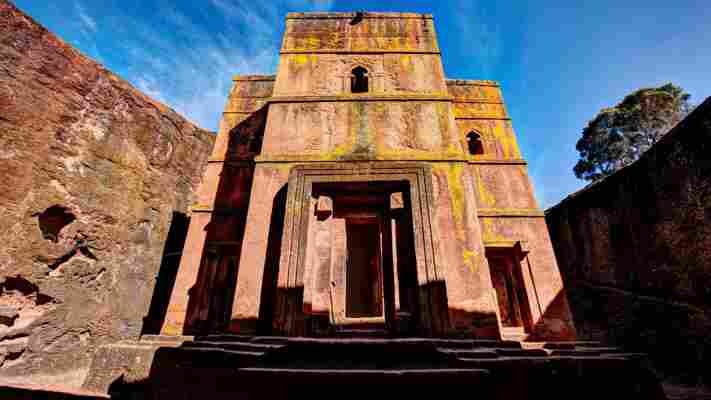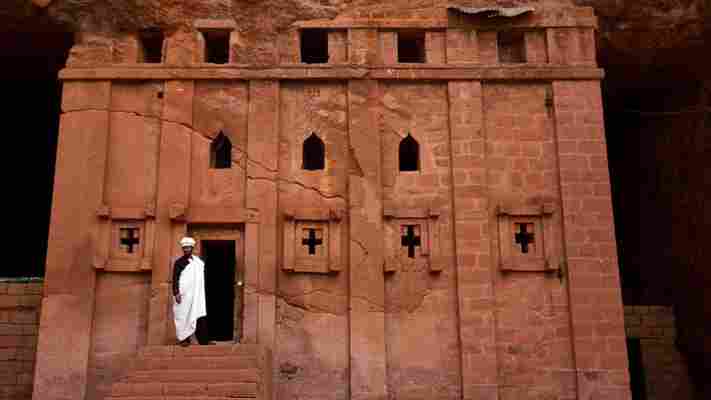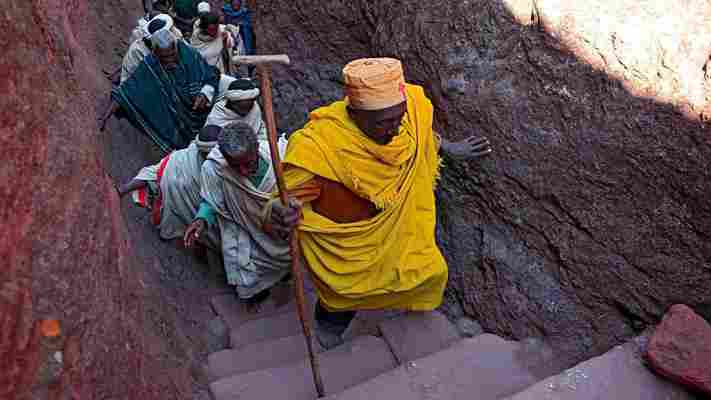Article continues below
I have always questioned God’s existence, but in the northern Ethiopian town of Lalibela, I was presented with fairly substantial evidence.
Officially Christian since 330AD, Ethiopia claims to be the oldest Christian country in the world. And despite being ravaged by poverty, faith has remained strong over the centuries; Lalibela’s medieval rock-hewn churches are clear proof of that.
Each of the 11 monolithic structures is dramatically stamped into the mountainous landscape, plunging 40 to 50m into the Earth and pierced with cross-shaped chiselled openings to let sunlight into the hollowed-out interior.

Lalibela’s monolithic churches plunge 40 to 50m into the ground (Credit: GRANT ROONEY PREMIUM/Alamy)
You may also be interested in: – The village powered by divine light – A rare glimpse at Jesus' burial chamber – A silent city hidden in the desert
There are several theories surrounding the creation of these extraordinary places of worship. Some believe they were carved by the Knights Templar, Christian crusaders who, during the 13th Century when the churches were created, were at the height of their power. But there’s no concrete evidence of their involvement.
The most heavily circulated hypothesis – and the one propagated by the small museum near the entrance to the churches – is that they were hewn under the orders of King Lalibela, emperor of Ethiopia during the late 12th and early 13th Centuries, who is said to have visited Jerusalem in 1187BC just before the Holy City fell to Muslim forces. King Lalibela built these churches around Ethiopia’s own stretch of the Jordan River, his intent being to welcome Christians to a ‘New Jerusalem’.
Yet the museum doesn’t seem to put its heart into pushing this theory; its display of construction tools includes only a fragile adze, an axe-shaped tool that King Lalibela’s workers supposedly used to sculpt the churches from the ground. Even allowing for 900 years of wear, it looked better suited to hooking weeds out of soil than carving rock.

The people of Lalibela believe the churches were carved overnight by angels (Credit: GillesBarbier/imageBROKER/Alamy)
Instead, the thousands of worshippers who attend daily services inside the churches accept a much more divine explanation: that King Lalibela was assisted by an army of angels, who completed the 11 churches in one night.
From a distance, the only sign of these underground temples is the stream of people flowing in and out of crevices. Visits have to be timed for the moments when congregations ebb, using the intermissions in daily services to negotiate the canyons, sometimes just wide enough for a single person, leading down into the Earth. With my hand against the wall, I slowly descended into the shadows of the churches.
Even between prayer sessions the churches are never empty; elderly worshippers find it easier to stay nearby than negotiate the precarious paths. They watched, leaning inscrutably on prayer sticks, as I unlaced my hiking boots and added them to the small scatter of flip-flops and slippers that lay outside. As I entered Biete Golgotha Mikael, said to be the final resting place of King Lalibela himself, the threadbare red carpet did little to mask the feeling of cool stone on the bottom of my feet. My eyes adjusted to the darkness and a medieval figure took shape – it was St Peter, etched into the wall of New Jerusalem for eternity.

Narrow passageways lead worshippers down into the Earth to the church entrances (Credit: Bildagentur-online/Alamy)
Slender paths and tunnels led me from church to church, but one was set apart; of the 11 houses of worship in the complex, Biete Giyorgis, a good long stone’s throw from the main warren of churches, was the most memorable. Its cruciform shape, immaculately buried in gently sloping rock, is topped with an etched Coptic cross that can only be seen from above. Its sheer walls have been tanned bronze over the ages, and plunge 40m into the surrounding chasm. Despite standing open to the elements, the structure is immaculately preserved, wearing its nine centuries with grace.
Not all the churches have fared as well. Biete Medhane Alem, accepted as the largest monolithic church in the world, is sheltered from the elements by a rather clunky slab of Unesco-issued sheet metal to prevent further erosion. And the walls of the Biete Abba Libanos feature a few alarming cracks.
Upon noticing these hints of decay, I had my doubts about the churches’ divine origins: surely if the churches of Lalibela had been built by angels, they would all still be in perfect condition.
Biete Giyorgis church (pictured) is shaped like a Coptic cross (Credit: Jarek Winniczek/Getty Images)
But as I emerged from the carved channel that led to Biete Giyorgis, I realised it didn’t matter how the churches came to be. Far below, a new wave of visitors were passing through the church's towering stone entryways, lintels that have been worn smooth by the footfall of centuries. They descended into the Earth, disappearing into the darkness cast by the monoliths and emerging again, having passed through the structures, to climb back up towards the sunlight. At the edge of the crevices, young men helped elderly worshippers navigate the sloping trails. I lingered for several minutes to watch the seemingly never-ending stream of pilgrims return above ground. They believed, and that was enough.
Join over three million BBC Travel fans by liking us on Facebook , or follow us on Twitter and Instagram .
If you liked this story, sign up for the weekly bbc.com features newsletter called "If You Only Read 6 Things This Week". A handpicked selection of stories from BBC Future, Earth, Culture, Capital and Travel, delivered to your inbox every Friday.
Leave a Comment